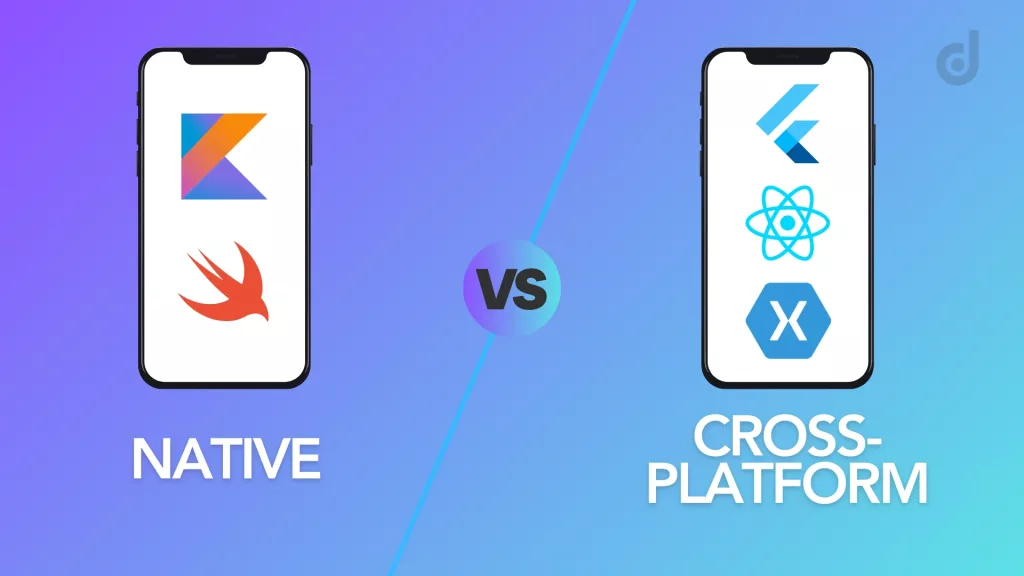The mobile app market is booming, with over 7.41 billion smartphone users worldwide projected in 2024 according to Statista. To capitalize on this massive audience, businesses need to choose the right development approach for their app. Two main contenders emerge, native and cross-platform development. But with each offering distinct advantages and disadvantages, selecting the right path can be a challenge.
This comprehensive guide dives deep into the world of native vs cross-platform development. We’ll explore what each entails, analyze their strengths and weaknesses, and equip you with the knowledge to make an informed decision for your app. Whether you prioritize a lightning-fast, platform-specific experience or a cost-effective solution that reaches multiple platforms quickly, this guide will illuminate the best path forward.
What is Native App Development?

Native apps are designed and coded to function flawlessly on a specific operating system, either iOS (for iPhones and iPads) or Android (for various smartphones and tablets). Native apps leverage the device’s unique features and programming languages (like Swift for iOS and Kotlin for Android) to deliver an optimal user experience (UX).
Here’s how it works: developers leverage programming languages specific to each platform. For instance, Swift is the primary language for native iOS app development, while Kotlin or Java is used for Android. This tailored approach allows native apps to seamlessly integrate with the operating system’s features and functionalities.
The result? A smooth, responsive user experience that feels like an intrinsic part of the device.
Examples of Best Native Apps
When it comes to native app development, some industry giants stand out as testaments to its potential. Here are a few examples that leverage the power of native features to deliver exceptional user experiences:
1. Instagram
This social media powerhouse Instagram, thrives on native development. The app’s smooth scrolling, intuitive camera integration, and seamless use of device features like push notifications are all possible thanks to its native roots.
2. Spotify
Offering a rich music streaming experience, Spotify leverages native development to deliver high-fidelity audio playback, efficient battery usage, and smooth offline functionality that feels natural on both iOS and Android devices.
3. Uber
This ride-hailing app relies heavily on native features like GPS location services and real-time mapping to provide a seamless user experience. Native development allows for smooth integration with these functionalities, ensuring a quick and reliable experience for both riders and drivers.
4. Pokemon Go
This augmented reality (AR) phenomenon took the world by storm. Native app development allowed Pokemon Go to leverage the device’s camera and gyroscope for an immersive AR experience, perfectly suited for both iOS and Android users.
These are just a few examples, but they showcase the potential of native development to create best-in-class apps that feel like an extension of the device itself.
Benefits of Native App Development
Choosing the native development path comes with a treasure trove of advantages. Let’s explore some of the key benefits of native app development:
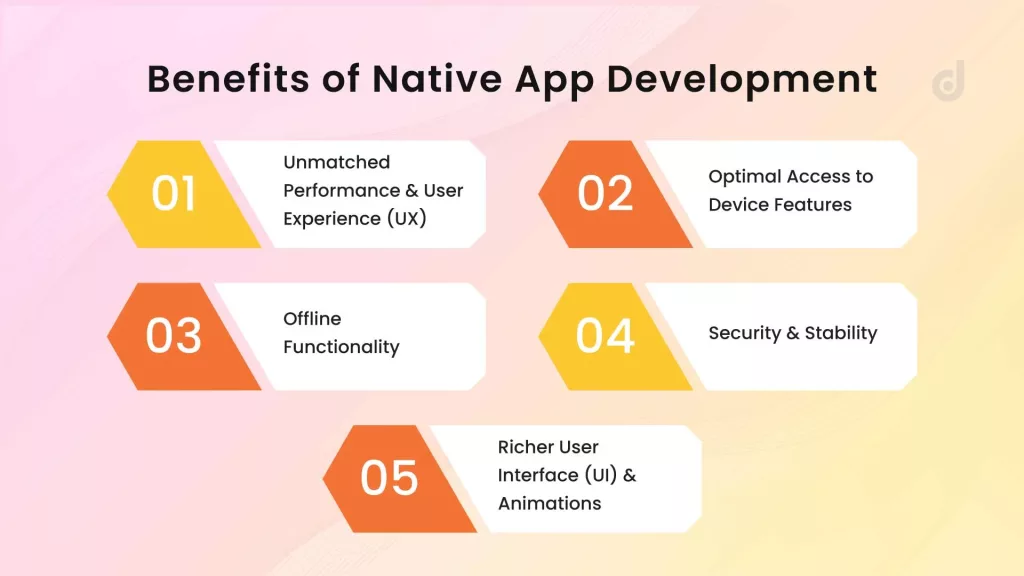
1. Unmatched Performance & User Experience (UX)
Since native apps are built specifically for a single platform, they can leverage the operating system’s full potential. This translates to smooth, responsive performance, faster loading times, and a more intuitive user experience that feels like a natural part of the device.
2. Optimal Access to Device Features
Native development grants full access to a device’s features like camera, GPS, microphone, and sensors. This allows for functionalities that might be limited or require additional workarounds in cross-platform apps. Imagine an Instagram built without native camera integration – not an ideal user experience!
3. Offline Functionality
Many native apps can function effectively even without an internet connection. This is particularly valuable for apps like maps, note-taking tools, or music players that users might rely on even when offline.
4. Security & Stability
Native development often offers a more secure environment due to tighter integration with the platform’s security features. Additionally, native apps tend to be more stable and experience fewer crashes compared to some cross-platform alternatives.
5. Richer User Interface (UI) & Animations
Native development allows developers to take full advantage of the platform’s UI elements and animation capabilities. This results in a more visually appealing and engaging user experience that aligns perfectly with the device’s design language.
Disadvantages of Native App Development
While native development offers a plethora of advantages, it’s important to consider the potential drawbacks before making a final decision. Here are some key factors to keep in mind:
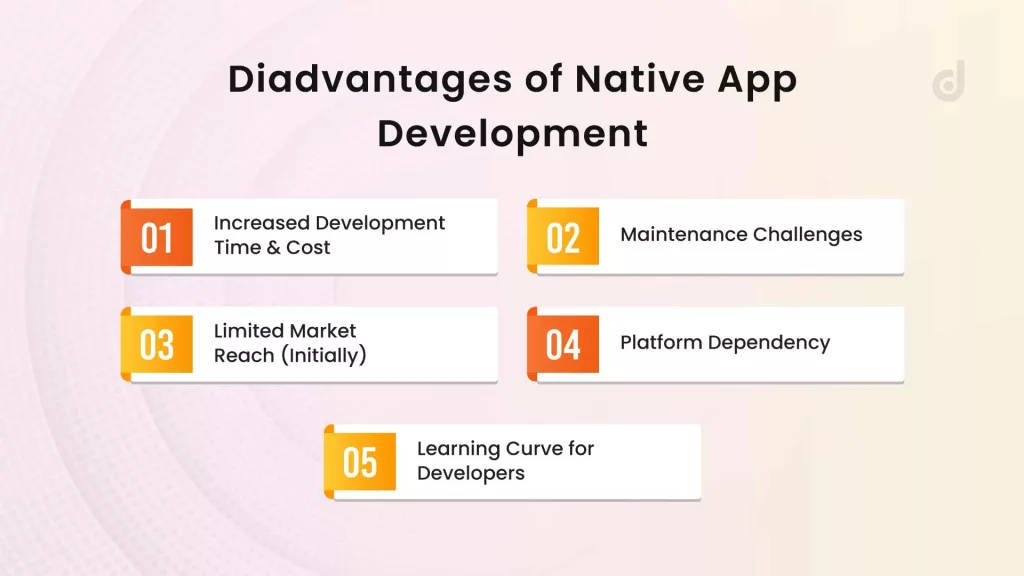
1. Increased Development Time & Cost
Building separate native apps for iOS and Android requires more time and resources. You’ll need developers skilled in each platform’s specific languages and frameworks, leading to potentially higher app development costs compared to cross-platform approaches.
2. Maintenance Challenges
Maintaining two separate codebases can be a significant ongoing effort. Bug fixes, feature updates, and keeping pace with platform changes all require attention for both iOS and Android versions of your app.
3. Limited Market Reach (Initially)
Launching separate native apps means reaching each platform’s audience independently. This can limit your initial market reach compared to a single cross-platform app.
4. Platform Dependency
Native apps are beholden to the specific platform’s release cycles and update schedules. Integrating the latest features or functionalities might require waiting for the respective platform’s update, potentially delaying the rollout of new features in your app.
5. Learning Curve for Developers
For development teams unfamiliar with platform-specific languages like Swift or Kotlin, there’s a steeper learning curve compared to using a single framework for cross-platform development.
Tools for Native App Development
Having explored the advantages and disadvantages of native app development, let’s delve into the world of tools that empower developers to bring these high-performing apps to life.
Here are some of the most popular tools for native development on each major platform:
For iOS Development:
- Xcode: Developed by Apple itself, Xcode is the go-to IDE (Integrated Development Environment) for building iOS apps. It offers a comprehensive suite of tools for coding, debugging, testing, and deploying apps on Apple devices. The primary programming languages used with Xcode are Swift and Objective-C.
For Android Development:
- Android Studio: This official IDE from Google is the industry standard for Android app development. Similar to Xcode, Android Studio provides a comprehensive environment for coding, testing, and deploying apps on Android devices. The primary programming languages used with Android Studio are Kotlin and Java.
These tools offer a robust foundation for building native apps. However, the specific tools and technologies used can vary depending on the project’s complexity and the developer’s preferences.
When to Consider Native App Development?
Now that we’ve explored the intricacies of native development, a crucial question remains: when is it the ideal choice for your mobile app project? Here are some scenarios where native development might be the most suitable path:
1. Prioritizing Performance & User Experience
If your app demands top-notch performance, seamless user experience, and smooth interaction with device features, native development is the way to go. This is particularly important for apps in gaming, social media, productivity, or augmented reality (AR) spaces.
2. Building a Premium App
For apps aiming to deliver a high-end, platform-specific experience, native development allows for a more polished look and feel that aligns perfectly with the device’s design language.
Leveraging Device-Specific Features: If your app heavily relies on functionalities like the camera, GPS, or advanced sensors in a nuanced way, native development offers the most direct and optimized access to these features.
3. Long-Term Investment
If you envision your app evolving into a feature-rich powerhouse with a large user base, the potential drawbacks of maintaining separate codebases might be outweighed by the long-term benefits of native development in terms of performance and user experience.
4. Targeting a Specific Platform
If your target audience primarily uses one platform (iOS or Android), focusing on native development for that specific platform allows for a more focused and potentially faster development process.
5. Security-Critical Applications
For apps handling sensitive data or requiring robust security measures, native development can provide a more secure environment due to its tighter integration with the platform’s security features. Financial apps, healthcare applications, or any app dealing with sensitive user information might benefit from the security advantages of native development.
6. Access to Latest Device Features
If your app relies heavily on the newest features and functionalities offered by the latest iOS or Android versions, native development allows you to take full advantage of them as soon as they become available. This is crucial for apps that want to stay at the forefront of technological advancements.
What is Cross-Platform App Development?

Cross-platform development utilizes tools and frameworks that allow you to write code once and deploy it on both iOS and Android devices. This approach streamlines the development process and can potentially reduce cross-platform app development costs compared to native development.
But how does it work? There are two primary approaches to cross-platform app development:
- Web-based Frameworks: These frameworks (React Native or Flutter) use web technologies like HTML, CSS, and JavaScript to build the app’s core functionalities. The framework then translates this code into native code for each platform, allowing the app to run smoothly on both iOS and Android devices.
- Hybrid Frameworks: These frameworks (Ionic) combine web technologies with native components. The app itself is a WebView (a container that displays web content within the native app), but it can leverage native functionalities like camera access or GPS through plugins.
By leveraging these approaches, cross-platform app development offers a unique solution for businesses seeking to reach a wider audience without the resource demands of separate native apps.
Examples of Best Cross-Platform Apps
Cross-platform development has come a long way, and several successful apps showcase its potential to deliver high-quality user experiences. Here are a few examples of well-known apps built with cross-platform frameworks:
1. Netflix
This streaming giant leverages the power of React Native to deliver a seamless user experience across both iOS and Android devices. The app offers smooth navigation, intuitive search functionalities, and high-quality video playback, all built with a cross-platform approach.
2. Airbnb
This hospitality marketplace thrives on a cross-platform app, allowing users to search for rentals, book stays, and manage reservations. Built with React Native, the app offers a user-friendly interface and efficient functionality for both iOS and Android users.
3. Duolingo
This popular language-learning app utilizes the capabilities of Flutter to deliver an engaging and interactive experience. The app offers gamified learning elements, voice recognition features, and personalized learning paths, all accessible through a single cross-platform codebase.
4. Instagram (Some features)
While Instagram’s core functionality is built natively for iOS and Android, it leverages React Native for certain features that require less platform-specific optimization. This demonstrates the flexibility of cross-platform development for integrating specific functionalities within a primarily native app.
These examples showcase the ability of cross-platform development to create feature-rich and user-friendly mobile apps.
Benefits of Cross-Platform App Development
The allure of cross-platform app development lies in its ability to streamline the app development process and reach a wider audience. Let’s explore some of the key benefits that make this approach so attractive:
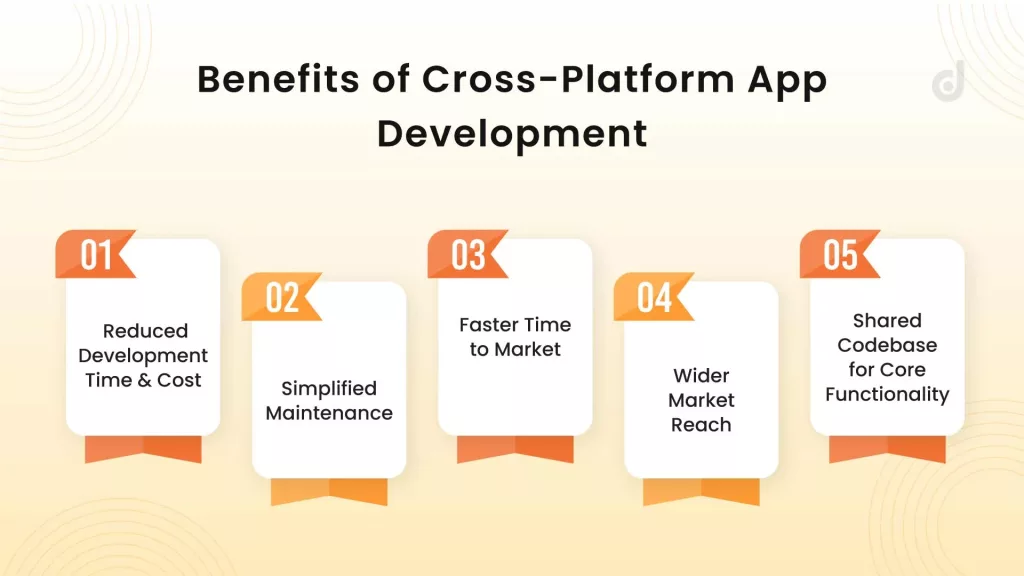
1. Reduced Development Time & Cost
Building a single codebase for both iOS and Android translates to faster development and potentially lower costs compared to creating separate native apps. This can be a significant advantage for businesses with limited budgets or tight deadlines.
2. Simplified Maintenance
Maintaining a single codebase is considerably easier than managing separate native apps for each platform. Bug fixes, feature updates, and keeping pace with platform changes require less effort with a cross-platform approach.
3. Faster Time to Market
With a single codebase to deploy, you can potentially reach both iOS and Android users simultaneously. This faster time to market allows you to capitalize on market opportunities and get your app in front of users quicker.
4. Wider Market Reach
A single cross-platform app can instantly reach users across both iOS and Android ecosystems. This broader market reach can be invaluable for businesses looking to maximize their user base from the get-go.
5. Shared Codebase for Core Functionality
Cross-platform development allows you to share the core functionalities of your app between iOS and Android versions. This is particularly beneficial for features that don’t require significant platform-specific optimizations.
Disadvantages of Cross-Platform App Development
While cross-platform development offers a compelling set of advantages, it’s important to consider the potential drawbacks before making a final decision. Here are some key factors to keep in mind:
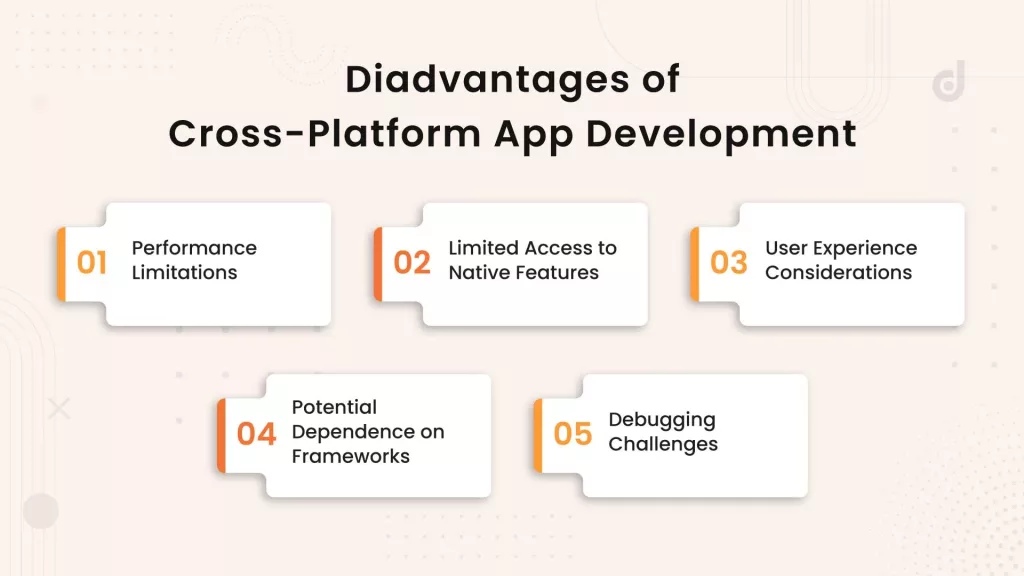
1. Performance Limitations
Compared to native apps, cross-platform apps might experience slight performance drawbacks. This is because the code needs to be translated to run on each platform, potentially leading to slower loading times or less smooth animations.
2. Limited Access to Native Features
While cross-platform frameworks are constantly evolving, they might not always provide the same level of access to all native device features as native development. This could limit the functionality of your app if it relies heavily on specific features like advanced camera controls or sensor data.
3. User Experience (UX) Considerations
Since cross-platform apps don’t leverage platform-specific UI elements and functionalities as deeply as native apps, the user experience might feel slightly less intuitive at times. This can be mitigated with skilled development, but it’s a factor to consider.
4. Potential Dependence on Frameworks
Cross-platform development relies on specific frameworks (like React Native or Flutter). While these frameworks are generally mature and well-supported, any limitations or future changes within the framework could impact your app.
5. Debugging Challenges
Debugging issues in a cross-platform app can sometimes be more complex compared to native development. This is because the underlying code might be abstracted by the framework, making it slightly trickier to pinpoint the root cause of problems.
Popular Frameworks for Cross-Platform App Development
The world of cross-platform development offers a variety of frameworks, each with its strengths and use cases. Here’s a glimpse at some of the most popular options to consider for your next mobile app project:
React Native
Developed and supported by Facebook, React Native is a leading framework that utilizes JavaScript and React code to build cross-platform apps. It boasts a large community, extensive documentation, and a strong focus on UI development, making it a great choice for creating visually appealing and interactive apps.
Flutter
Developed by Google, Flutter uses the Dart programming language to build beautiful and high-performance apps. Flutter offers a unique approach where the framework itself renders the UI elements, potentially leading to smoother performance and a more native-like feel compared to other frameworks.
Xamarin
Owned by Microsoft, Xamarin is a mature framework that leverages C# for cross-platform development. It provides tight integration with Microsoft tools and Azure cloud services, making it a valuable option for businesses already invested in the Microsoft ecosystem.
Ionic
Built with web technologies like HTML, CSS, and JavaScript, Ionic is a popular framework for creating hybrid apps. It excels at developing apps with a strong web app feel and leverages Cordova plugins to access native device functionalities.
These are just a few of the best cross-platform development frameworks available. The best choice for your project will depend on factors like your app’s complexity, desired features, developer skillset, and budget.
When to Consider Cross-Platform App Development?
Now that we’ve explored both native and cross-platform development approaches, you might be wondering – is cross-platform the right fit for your mobile app project? Here are some scenarios where cross-platform development can be a strategic choice:
1. Focus on MVP (Minimum Viable Product)
If your goal is to get a core version of your app into the market quickly and reach a broad audience across iOS and Android, cross-platform development can be a great way to achieve this. The faster development time and wider market reach can be advantageous for validating your concept and gathering user feedback.
2. Simpler Apps with Basic Functionalities
For apps that don’t require complex functionalities or deep integration with device-specific features, cross-platform development can be a cost-effective solution. This approach can be suitable for basic utility apps, information portals, or internal business tools.
3. Limited Budget & Resources
If your budget or development team size is constrained, cross-platform development can help you create a mobile app within your limitations. The single codebase approach can help you manage resources more efficiently compared to building separate native apps.
4. Need for Fast Iteration & Updates
Cross-platform development allows for quicker updates and easier implementation of new features across both iOS and Android versions. This can be beneficial for apps that require frequent updates or need to adapt to changing market demands.
5. Targeting a Global Audience
If your target audience spans both iOS and Android ecosystems, a single cross-platform app can be a strategic choice. This eliminates the need for separate marketing efforts for each platform and allows you to focus on reaching a wider user base from the get-go.
Native Vs Cross-Platform App Development Approach?
Choosing between native and cross-platform development can feel like navigating a crossroads. But fear not! By following this comprehensive framework, you can make a well-informed decision that propels your mobile app towards success:
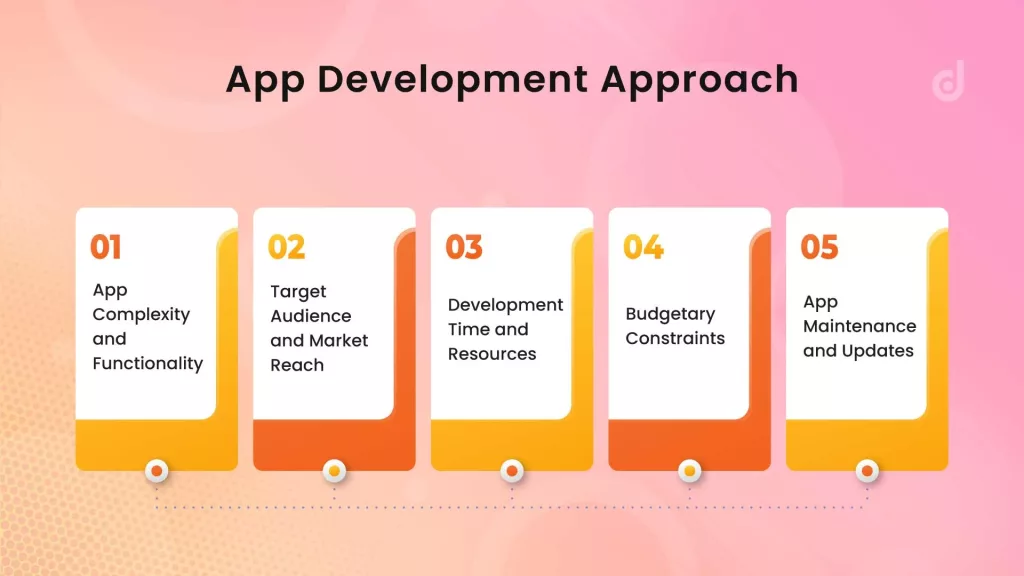
1. App Complexity and Functionality
- High Complexity: If your app demands exceptional performance, intricate UI animations, or deep integration with device features, native development is likely the better choice.
- Simpler Functionalities: For basic apps with straightforward functionalities, cross-platform development can be a cost-effective solution.
2. Target Audience and Market Reach
- Specific Platform Focus: If your target audience primarily uses iOS or Android, native development allows you to tailor the app for that specific platform.
- Global Reach: If you want to reach a broad audience across both iOS and Android, cross-platform development offers wider market reach with a single app.
3. Development Time and Resources
- Limited Resources: For projects with tight deadlines or smaller development teams, cross-platform development can expedite the process with a single codebase.
- Focus on Performance and User Experience: If development time is flexible and prioritizing top-notch performance and user experience, native development is the way to go.
4. Budgetary Constraints
- Cost-Effectiveness: Cross-platform development generally requires less development effort, translating to potentially lower costs compared to building separate native apps.
5. App Maintenance and Updates
- Simplified Maintenance: Maintaining a single codebase for cross-platform apps can be easier than managing separate native apps for each platform.
- Frequent Updates: If your app requires frequent updates or new feature rollouts, cross-platform development allows for faster implementation across both iOS and Android.
Ultimately, the key is to choose the approach that best equips your mobile app to succeed in the marketplace. By carefully considering your project’s requirements and leveraging the insights from this guide, you’ll be well on your way to making an informed decision for your next mobile app development journey.
Conclusion
The world of mobile app development presents a strategic choice: native vs cross-platform. While native development offers unparalleled performance and user experience, cross-platform development streamlines the process and widens your reach.
The ideal approach hinges on your project’s specific requirements. By carefully considering the factors explored in this guide – app complexity, target audience, development resources, budget, and maintenance needs – you’ll be empowered to make an informed decision.
Ready to embark on your mobile app development journey?
Digimonk Solutions is a team of passionate app developers with extensive experience in both native and cross-platform development. We can help you navigate the complexities of the decision-making process, craft a winning development strategy, and build a high-quality mobile app that exceeds your expectations.
Contact us today for a free consultation! Let’s turn your mobile app vision into a reality.
